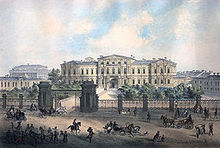Page Corps (Russia)
The Pagencorps ( Russian Пажеский корпус Pascheski korpus , French Corps des Pages) was a military academy in the Russian Empire , in which the sons of the nobles and sons of the high military were prepared for military service . At the same time, the Imperial Law School ( Russian Императорское училище правоведения Imperatorskoje Uchilishche prawowedenija ) trained the next generation of civil servants. Together they were the most prestigious schools in Saint Petersburg in their day . After 1943 the Suvorov Military School (Russian Суворовское военное училище Suvorovskoye wojennoje utschilishche ) took over this function.
history
The Pagencorps was founded in 1759. First of all, the pupils should receive training there as pages or chamber pages . However, the need to have well-trained officers for the Russian Guard soon became apparent, and in 1802 the page corps was converted into an educational institution comparable to cadet schools. Only sons of aristocrats and sons of the military with at least the rank of lieutenant-general / vice-admiral or grandson of generals / admirals were accepted.
The curriculum was designed based on the ideals of the Knights of St. John . In 1810 the school moved to the Palace of the Order of the Knights of St. John of Jerusalem ( Vorontsov Palace , Воронцо́вский дворе́ц). The institution existed in this place until the Russian Revolution .
In the 1860s, Dmitri Milyutin initiated a series of reforms and the page corps was transformed into a seven-year school. The first five years of school corresponded to high school education , while the last two years of school followed the curriculum of military colleges.
From 1885 the page corps had seven classes in which the pupils received the same training as in cadet schools, as well as two specialized classes in which the pupils learned military science and law . There were separate infantry , cavalry and artillery divisions. The Corps des Pages , as it was called in pre-revolutionary Russia, was the only military academy (of around 20) that trained future officers on all weapons. The other academies specialized in cavalry, infantry, artillery, military engineering, Cossacks , surveying, etc.
Most of the graduates entered the army as officers . However, a small proportion also aspired to diplomatic or civil careers.
Cadet life
Like other military schools, the page corps subjected the cadets to strict discipline. Corporal punishment, including whipping with a birch broom, and abuse of the younger cadets by the older ones were the order of the day. Peter Kropotkin's memoirs give details of the Bizutage and other abuse cases. The training, on the other hand, was of a relatively high standard.
Privileges and role at court
The cadets served as pages at court according to a shift system and were used for duties at ceremonies and even for individual service with members of the royal family.
Graduates had the unique privilege of joining a regiment of their choice, regardless of whether there was a vacancy there. Only the approval of the commanding officer had to be asked out of courtesy. As officers, they wore the Corps des Pages pin on the left side of their robes, which was modeled on the St. John's Cross. The graduates received the rank of Podporuchik ( Cornet in the cavalry). Those who entered the diplomatic or civil service received ranks of 10th, 12th and 14th grade.
uniform
The corps had a variety of different uniforms for different occasions. The most elaborate was the gala uniform for the court of the tsars. It comprised a pimple helmet with a white feather, a dark green jacket with gold braids, white breaks, and high boots.
resolution
By 1917 4,505 officers had been trained. Another 200 were unable to complete their training due to the 1917 revolution. The school ended the lessons in February 1917 after the abdication in 1917 of Nicholas II. And was established in June of the same year by Alexander Kerensky , the war minister of the transitional government , finally closed.
Individual evidence
- ↑ a b c Daniel EA Perret The Sovereign Order of Saint John of Jerusalem Knights of Malta and the "Corps des Pages", Russia's Dream of Chivalry ( Memento of the original from December 24, 2007 in the Internet Archive ) Info: The archive link was inserted automatically and not yet checked. Please check the original and archive link according to the instructions and then remove this notice. .
- ^ Tanya Chebotarev, Marvin Lyons: The History [1] of The Russian Imperial Corps of Pages, An Online Exhibition Catalog. Columbia University Libraries 2002. "In the very heart of St. Petersburg stands a magnificently proportioned, medium-sized palace, designed in the mid-eighteenth century by the Italian architect Bartolomeo Rastrelli. The fine old palace was given by the Emperor Paul to the exiled Order of the Hospitalers of Saint John of Jerusalem (the Knights of Malta) in 1796. In 1810, Alexander I gave this palace to the Corps of Pages as the headquarters. It was a gift with great symbolic meaning. The Knights left the Palace with a Catholic chapel in the garden and Maltese Crosses everywhere. The crosses and the chapel remained and the young Pages took very seriously the thought that they were the heirs of the Order, adopting many of its traditions as their own and the white Maltese Cross as their insignia.
- ↑ Vladimir Littauer: Russian Hussar. 11. ISBN 1-59048-256-5
- ^ Robert HG Thomas: The Russian Army of the Crimean War : 13. ISBN 978-1-85532-161-8
- ^ Peter Kropotkin: Memoirs of a Revolutionist. Smith, Elder & Co., London 1899: 63. [2]
